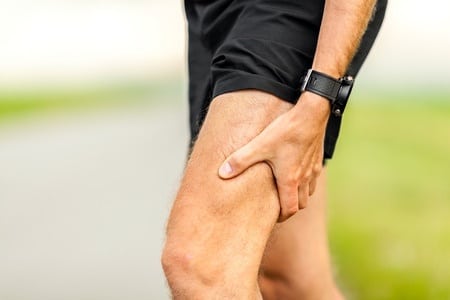
Hamstring injury is common in sports requiring periods of rapid acceleration. Soccer, rugby and football players are particularly at risk for hamstring injuries, but any athlete can be affected. Recent studies show that there is a high risk of re-injury to the hamstring with an early return to sports.
The hamstrings are a large muscle group in the back of your thigh. They run from the pelvis to the knee. When an athlete is accelerating rapidly, the hamstring contracts violently. With continued repetitive loads, the hamstring muscles and tendons can tear. The athlete will pull up and grab the back of the thigh.
Hamstring Injury
Hamstring injury can occur at different locations along the hamstring muscle-tendon unit. Injuries can occur near the pelvis, along the top of the thigh or the bottom of the thigh. Unless the tendons are completely torn off of the pelvis, which is very rare, these are non-surgical injuries. Physical therapists and athletic trainers work with these athletes to restore motion and strength, and then progress to agility training prior to return to sports. But given the research we are about to discuss, are we doing enough to protect our athletes from a recurrent or reinjury?
Hamstring Injury: When to Return To Sports
A recent study calls into question our current return to sports criteria.
This paper showed that 19 of 180 athletes with a hamstring injury suffered a recurrence or re-injury within a short period of time. The average time for return to sports was only 19 days. More than 50% of the reinjuries to the hamstring occurred within only 25 days. 70% of the reinjuries occurred within 3 months. If the injury occurred within the first 6 weeks after returning to sports, the same hamstring muscle was re-injured in the same place as the original injury. Perhaps more worrisome is that repeat MRI scans on the reinjured hamstring showed that the new injury was worse than the original injury.
Hamstring Reinjury
This paper shows that an early return to sports following a hamstring injury results in a very high risk of developing a recurrent injury in the same muscle. Furthermore, this study shows that our current return to sports criteria need to be reevaluated. Once again, the biological process wins. We were obviously not giving the hamstring injury time to truly heal from a biological and functional perspective. We need to give our athletes more time for their muscles and tendons to heal back to a point where the risk of reinjury is very small. With the enormous pressures on owners, athletic directors, and coaches to get their players back on the field, the athletes, and parents of adolescent athletes need to take a step back and think about the risks of returning to sports too quickly after a severe hamstring injury.
More attention to posterior chain strengthening, and the Nordic Hamstring exercise program should be considered during team training to minimize the risk of developing your first hamstring injury ~!















